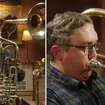Bach - Orchestral Suite No. 3 in D
Containing his Air on a G string, Bach composed four orchestral suites, including his most famous offering, the Orchestral Suite No. 3 in D, BWV 1068.
Bach wrote a total of four orchestral suites, the best-known of these being the third. It was written, along with the others, during the last period of his life in Leipzig, around 1731. Despite being labelled 1, 2, 3, and 4, the pieces weren't written in this order: Suite No. 1 almost certainly dates from around 1723, when Bach was Cantor of the Thomasschule, Suite No. 4 dates from before Christmas 1725, and No. 2 survives in manuscript form from 1738-9.
So, the numbering for the orchestral suites isn't entirely accurate. And, it seems, Bach's definition of 'orchestral' suites is pretty loose too. The group of musicians performing the work might be as small as a string quartet, a handful of woodwind players, some trumpets and a percussionist. Suite No. 3 is scored for three instrumental choirs – two oboes, three trumpets, timpani and strings.
The Air (the second movement) was transcribed for strings by August Wilhelmj, which made it a party piece playable on only one string of a violin – hence its nickname 'Air on the G string'. It's led scholars to believe the whole suite might have been composed for strings only, which would make it Bach's only known work written solely for four-part strings.




























